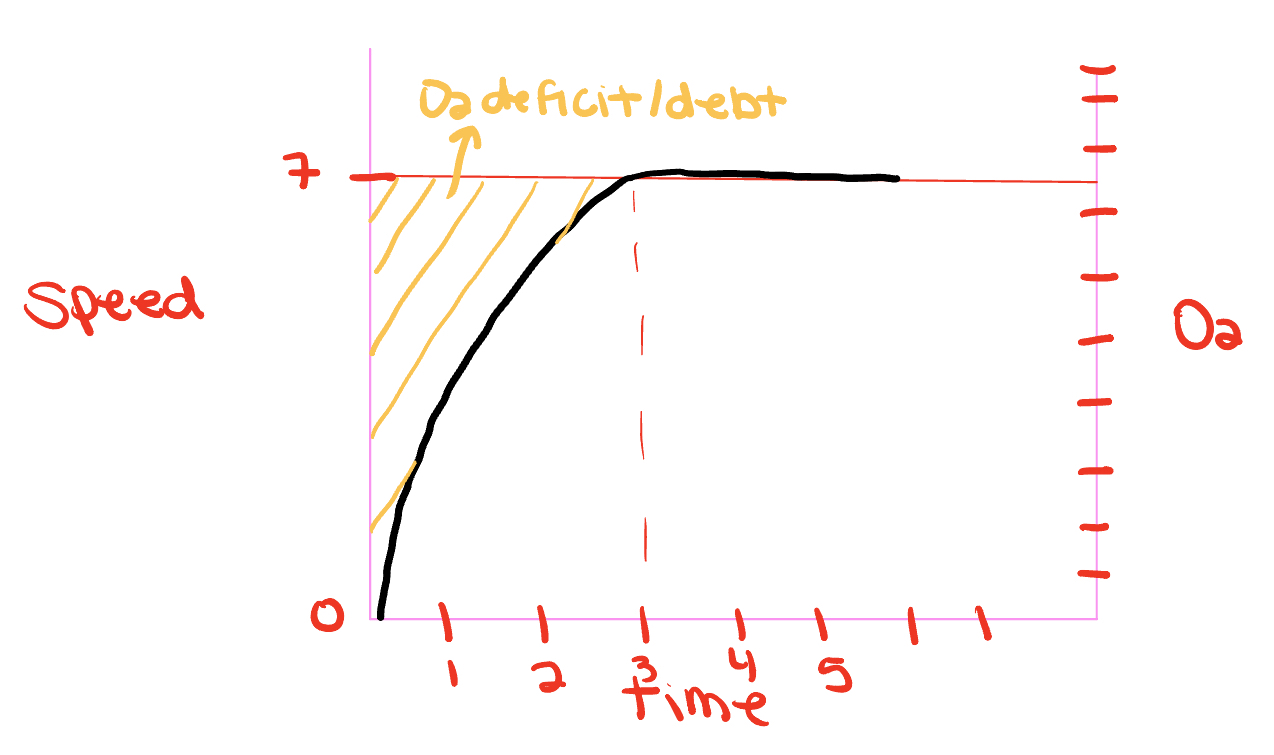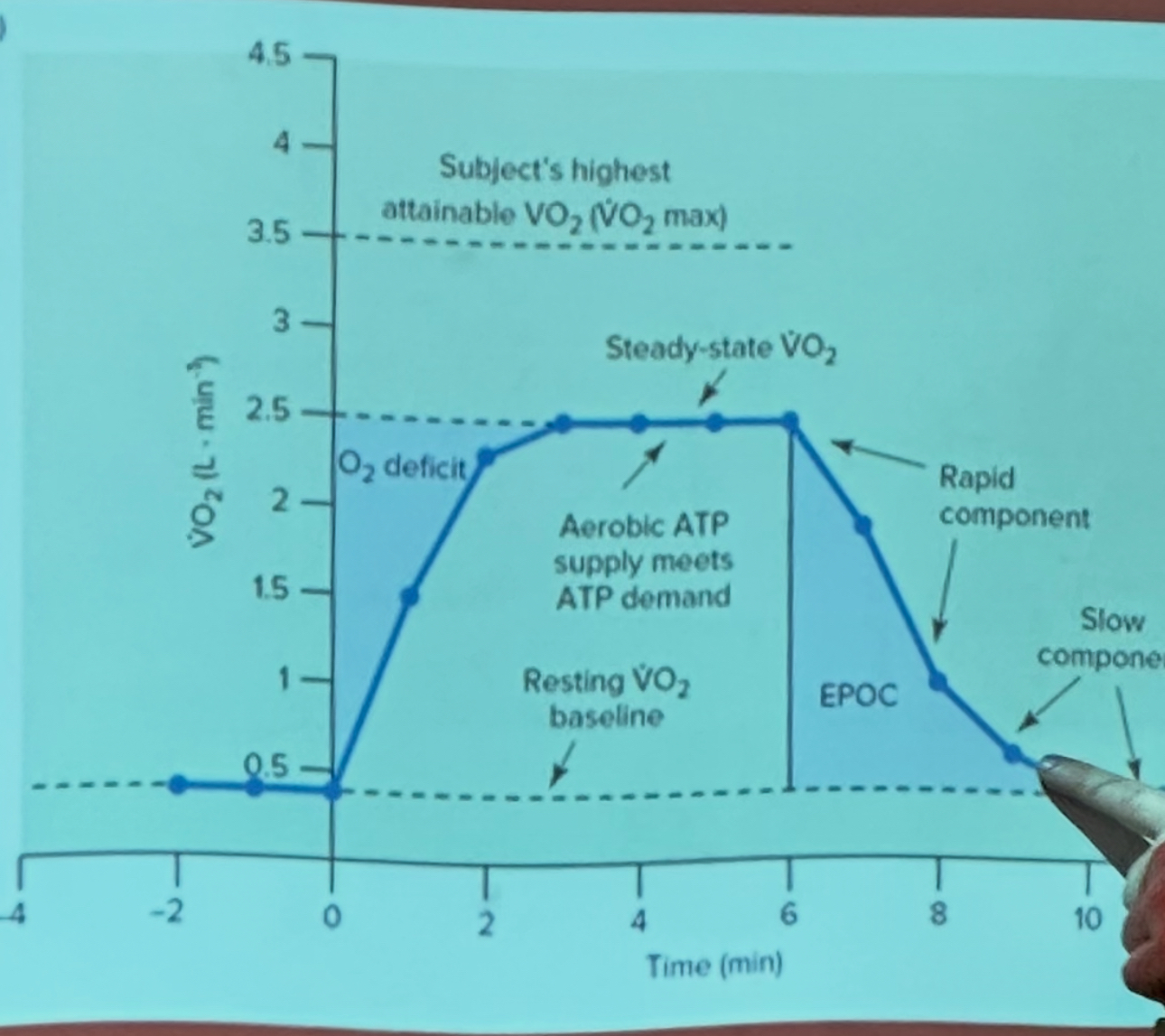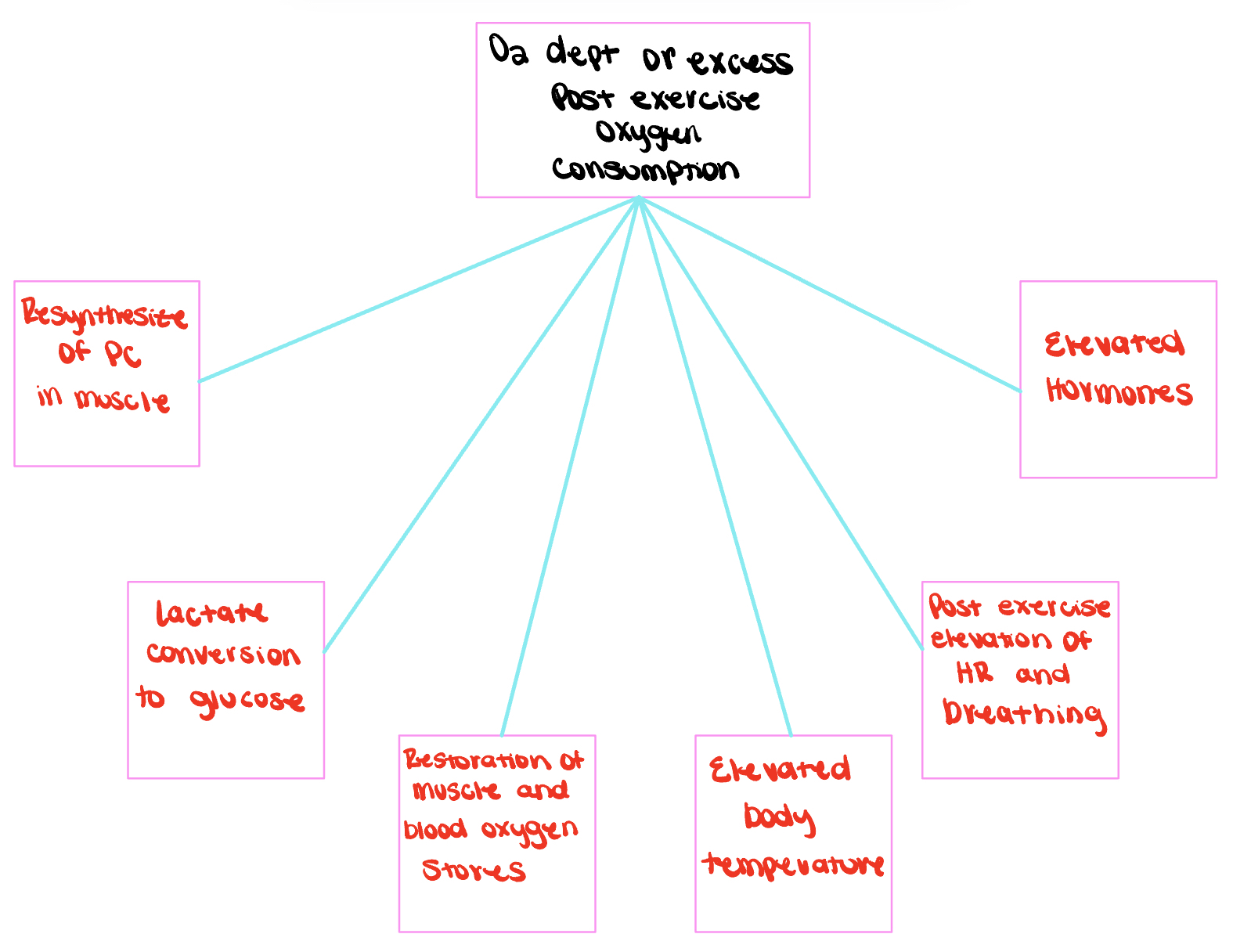Energy at rest
Energy requiremetns at Rest
Almost 100% of ATP produced by aerobic metabolism
Blood lactate levels are at low
Resting O2 Consumtion
0.25L per minute
Would a person produce enough ATP when going from sitting to 7mph on a treadmill right away?
Yes, otherwise they would fall and become limp
ATP comes from:
Stored
Phosphocreatine
Known as anaerobic energy system
How long would it take before anaerobic energy systems to catch up?
What would O2 consumption look like on a graph?
It only takes a few minutes
O2 Dept - taking out oxygen from our blood and breaking down the phosphocreatine and producing lactate from anaerobic glycolysis
We pay the O2 Dept back when you rest or lower intensity

Energy requirement during rest-to-exercise transitions
Atp production increases immediatly and oxygen uptake increases rapidly
Reaches steady state within 1-4 minutes
After steady state is reached, ATP requirment is met through aerobic ATP production
Initial ATP prodcution via anaerobic pathways
ATP-PC system
Glycolysis
Oxygen deficit
Lag in oxygen uptake at the beginning of exercise
Endurance trained individuals have lower O2 deficit than sedentary
Trained subjects have lower oxygen deficit-why?
they have a more efficient aerobic energy system
they have developed aerobic bioenergetic capacity due to cardiovascular (more capillaries) and muscular adaptatipon (greater mitochondrial volume)
Increased mitochondrial volume in muscle fibers result in less lactate production at the beginning of exercise
Recovery from Exercise
Oxygen uptake remains elevated above rest during recovery from exercise
Oxygen dept
Term coined by A. V. Hill
Hill believed that the elevated O2 consumption post exercise was repayment for O2 deficit at onset of exercise
Oxygen dept concept proved to be incorrect
Excess post-exercise oxygen consumption (EPOC)
Most recently, EPOC was coined to replace the term “Oxygen dept”
Terminology reflects that only around 20% elevated O2 consumption used to “repay” O2 deficit
Mechanisms responsible for rapid and slow components of EPOC
Rapid portion EPOC
Elevated O2 consumption used for:
Re-synthesized of stored PC in muscle
Replenishing muscle (myoglobin) and blood (hemoglobin) O2 stores

Mechanisms responsible for rapid and slow components of EPOC
Slow portion of O2 dept
Increased O2 needed for elevated heart rate and breathing
Increased body temperature = increased metabolic rate
Increased blood levels of epinephrine and norepinephrine = increased metabolic rate
Conversion of lactic acid to glucose (gluconeogensis)
Is Excess Post Exercise Consumption greatest in low-intensity exercise or high-intensity Exercise?
High intensity because we are using more anaerobic so there will be a great dept
Take body longer to recover from more lactate and greater body temperature increase

Once you get to steady state exercise, does your VO2 remain unchanged for the duration of the exercise?
It does not stay the same
In hot and humid environments our VO2 max will go down & O2 consumption goes up because we are breathing faster
At a higher intensity can we maintain a higher VO2 consumption
no we can’t
Because of increased heart rate
Dilation of respiratory passages
Increase in epinepheroine
What is VO2 Max?
Greatest oxygen uptake by the body measured during severe dynamic exercise,musually on a cycle ergometer or a treadmill; dependent on maximal cardiac output and the maximal arteriovenous oxygen difference
Endurance training programs typically involve continuous dynamic exercises like running, cycling, or swimming for over 20 minutes, three or more times a week at an intensity greater than 50% max
High-intensity interval training (30-120 seconds of all-out efforts) can also improve max. Over two to three months, such training can increase max by 15% to 20%, although improvements can range from 2% to 50% depending on individual genetic potential
Max varies based on age, health, and fitness level, with values below 20 ml · kg–1 · min–1 in those with severe health issues and over 80 ml · kg–1 · min–1 in elite athletes
Approximately 50% of max in untrained individuals is influenced by genetics
How do you verify that VO2 max has been reached during an incremental exercise test?
If a plateu in O2 consumtption is not achieved, what secondary criteria can confirm VO2 max has been acheieved?
Reaching an ge-predited max heart rate(+- 10 beats per/min) or roughly 5% age predicted
What are some factors that might influence a subjects performance on VO2 Max Test?
Diet
Cardiovascualr fitness
Muscle fiber type
Respiratoryt Efficiency
Altitude & humidity
Age
Gender
Is there a possible way to better classify our athletes aerobic performance if VO2 max is not always achievable ot reliable?
testing heart rate
testing lactate responds to exercise
Incremental exercises and lactate threshold
a point during a graded exercise test when the blood lactate concentration increases abruptly
intensity of exerixes where your body can no longer clear the lactate fast enough
happens around 50-60% VO2 Max
Also Called “Anaerobic Threshold”
onset of blood lactate accumulation (OBLA)
Exercise intensity at which lactate levels reach 4 m m o 1 per L
Lactate Threshold
During moderate-intensity exercise, most ATP production for muscle contraction comes from aerobic sources. As exercise intensity increases in an incremental test, blood lactate levels rise exponentially, appearing around 50-60% of maximum in untrained individuals, and at 65-80% in trained individuals. Previously referred to as the anaerobic threshold, this point is now more commonly called the lactate threshold due to debates over terminology.
The onset of blood lactate accumulation (OBLA) refers to the exercise intensity at which a specific blood lactate concentration (e.g., 4 mmol/L) is achieved, differing from the lactate threshold, which describes the inflection point of blood lactate levels. For clarity, we'll use the term lactate threshold to describe the sudden rise in blood lactate during incremental exercise.
Reasons for Lactate/Anaerobic Threshold
Limted O2 uptake - At higher intensities, the body’s ozygen uptakre may not meet the muscles increasing demand for ATP production through aerobic resporation. This oxygen deficit forces a switch to less efficient anaerobic pathways
Increased rate of glycosis - To compnesate for insufficent oxygen, glycosis accelerates, prodcuing pyruvate faster that it can be oxidized in the motchondria. The excess pyruvate is then converted to lactate
Reduced Mitochondrial Capacity - The capactiy of mithcondria to oxidize pyruvate is limited. If the rate of pyruvate production surpasses the mitochondira oxidative capacity, lactate accumulates
Enzyme Activity - Change sin enxyme acitivy, such as increased acitivity of lactate, dehydrogenase, accelerate lactate production
Hormonal Influence - Hormones such as epinepherine and nonepinepherine, released during intesne exercise, can indirectly affect lactate producion by influencng metabolic processes
Blood Flow and Lactate Removal - Efficient lactate removal from muscles and transprot to the liver for gluconeogenseisis (CORI CYCLE) is cruical for maintaing low lactate levels. Inadequates in blood lfow or lover finction can impact the lactate threshold
Recruitment of Fast-twitch Muscles Fibers - High-intensity exercise involves recuirting fast-twitch muscle fibeers which have lower oxidative capacity compared to slow-twitch fibers. These fibers rely more on anaerobic metabolism, producing lactate even with adequate oxygen supply
Measuring Intensity of the exercise
So many different ways we can measure the intensity of the exercise
Focusing on just endurcaance type events, how many different ways can we do this?
Percent of your heart rate max
percent of your VO2 max
Percentage of your maximal pace or percentage of your race pace
Percentage of your lactate threshold
Percentage of your venilatory threshold
Perceptual measures like RPE or the talk test
Percent of heart rate reserve
Three-Zone Intensity Method
https://m.youtube.com/watch?v=NPwyk9B0j-s
The three zone model divideds exercise intensity into three zones: low, moderate, and high intensity, based on physiological responses
By undertanding the different zones and their effects on the body, athletes can tailor their training to achieve specifc goals
By incorperating rest and recovery periods in Zone 1, athletes can prevent burnout and injuries
Combining trainging in all three zones leads to a well-rounded imporvment in fitness